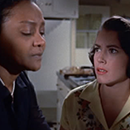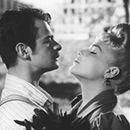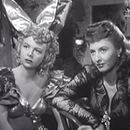CRUCIAL VIEWING
Douglas Sirk’s IMITATION OF LIFE (American Revival)
Doc Films (University of Chicago) – Saturday, 7 and 9:30pm
Douglas Sirk’s 1959 IMITATION OF LIFE occupies a paradoxical position, with its initial critical drubbing as a straightforward "shameless tear-jerker" (and continued appeal as such to philistines) on one hand, and on the other its delayed procession of revisionist interpretations (following Sirk's English-language outing as a disingenuous semiotic savant in Jon Halliday's 1971 book Sirk on Sirk) by poststructuralist/feminist film-studies academics and their camp- loving, reflexivity-obsessed students. Thus, the film can be read as alternately reinforcing and criticizing ideologies of capitalism, race, and patriarchy, through the progressively prominent role of the African-American housekeeper (Juanita Moore) of the successful, widowed white actress (Lana Turner), and the increasingly radical aspiration to the latter's status by the housekeeper's fair-skinned daughter (Susan Kohner). For R.W. Fassbinder (who saw IMITATION in Munich in 1971), "you can understand both of them, and both of them are right, and no one will ever be able to help either of them. Unless of course, we change the world" (125 min, 35mm) MC
Jacques Becker's CASQUE D'OR (French Revival)
Gene Siskel Film Center – Saturday, 5:30pm and Tuesday, 6pm
It is not uncommon to read a piece of film criticism that compares the work in question to another type of art. When realistic, a film might be compared to a photograph. When long, an epic novel. When short, a literary work of similar structure. When lyrical, a song, and when languid, a ballet. Such analogies are rarely literal and are typically intended to provide a familiar standard against which a reader might better relate to a film's technical or narrative idiosyncrasies. So to say that Jacques Becker's CASQUE D'OR is like an impressionist painting might be to suggest that it merely resembles a style of art which originated in 19th-century France while remaining at its core a film with only suggestions as to another medium's influence, rather than a painting itself come to life and on its own borrowed journey. The latter, however, is true of CASQUE D'OR, a painting-as-film that takes the visible brushstrokes of the Belle Époque off the canvas and onto the big screen. Made in 1952 and set fifty years beforehand, CASQUE D'OR is about the gloriously understated love between a beautiful gangster's moll and a reformed prisoner, and the inherent self-determination that brings them together and tears them apart. Initially disparaged as a humdrum period piece, the film has gone on to be lauded as Becker's magnum opus and credited as inspiration for generations of young filmmakers following suit. Its deceptive banality is the impetus for its staggering genius, further framing the series of paradoxes that linger below the surface of seemingly commonplace genre trope. A painting could be viewed in much the same way as Becker's film was originally received, with its rigid two-dimensional limitations leaving only the smallest amount of room for artistic nuance and viewer interpretation. Working with a story that was based on real events, it's no surprise that Becker would choose to utilize characteristics from one of the period's defining artistic movements, but the extent to which he does so beyond the obligatory aesthetic adherence is a testament to Becker as a sort of painter in addition to his title of director. As critic Philip Kemp noted in his essay for the Criterion Collection DVD release of the film, "It's a world seen whole, neither romanticized nor sensationalized, but presented as a complex, living community in its own right." Inspired by the advent of photography, impressionist artists aimed to capture the capricious nature of reality while maintaining the distinct aesthetic that would set them apart from their more literal peers. In Becker's case, it is a similar paradox that would both confuse and inspire young filmmakers; though cloaked in classicism, its devastating earnestness remains distinct from the self-consciousness of the New Wave, which it helped to inspire. Even the black and white photography, a significant mainstay of Becker's predecessors, sets him apart. It serves to illuminate the rich narrative duality, while suppressing the technical possibilities in earnest- some of the scenes that take place within nature are so beautiful that it's almost a favor to the viewer for them to be shown in black and white, so as not to distract them from the wonderfully doomed romance taking place within the thick. But even without the impressionist color palette, the absence of which is the film's greatest irony, Becker uses his skills as a filmmaker to paint an impressionistic picture rather than to just project it. Every aspect of the film, from the necessity of the actors for their specific roles to the subtext hidden behind their character's dress, is a perfectly applied brushstroke on the canvas that is Becker's great artistic vision. (1952, 94 min, 35mm) KS
Christopher Nolan’s DUNKRIRK (New British)
Music Box Theatre - Check Venue website for showtimes*
Christopher Nolan’s 10th feature film finds the director delving into the past to tell the story of Dunkirk, a moment during World War II in which 400,000 British and French soldiers find themselves cornered along the shore of the Strait of Dover with German forces closing in from all sides. Focusing on the extraction of the British soldiers, the film’s narrative is split into three timelines, from the perspectives of those on land, on the sea, and in the air. The most unique feature here is the differences in time dilation that each of these plot threads experiences—the time scale covering a week, a day, and an hour, respectively. Much like the structuring of Steven Soderbergh’s TRAFFIC, these scenarios are differentiated from one another via distinct tones. Despite being a war film and covering so much material, the film is relatively light on dialogue. Instead, Nolan seeks to create impact through visually stunning detail and intimate camera work. Cameras are strapped to planes, on boats, and to cameraman in the water, creating a deeply immersive experience. As seen throughout his oeuvre, in which he’s been a proponent of on-location shooting and the use of practical effects, the vast beaches coupled with huge warships create a daunting sense of scale. This immensity also helps to create isolation; some of the characters seem but a drop of rain in a storm—an impression accentuated by the use of soft focus during long shots. Hans Zimmer’s score creates foreboding and suspense. Rising and swelling like the sea itself, the music is underlined with the tick-tock of a pocket-watch, driving home the theme of elapsing time. Drawing inspiration from films as diverse as SUNRISE and SAVING PRIVATE RYAN, and building on ideas explored in Nolan’s own films MEMENTO and INCEPTION, DUNKIRK immerses its audience with its complex, interweaving storylines. (2017, 106 min, 70mm) KC
---
*DUNKIRK also has suburban 70mm showings, and is showing in multiple locations digitally.
ALSO RECOMMENDED
William A. Wellman's LADY OF BURLESQUE (American Revival)
Doc Films (University of Chicago) - Friday, 7 and 9pm
William A. Wellman and Barbara Stanwyck worked together wonderfully, her brassy screen persona complementing his gritty, rough-and-tumble direction. He gave her one of her first starring roles in NIGHT NURSE (1931), and she remained grateful to him for the rest of her career, acting for him another several times. LADY OF BURLESQUE, one of their later collaborations, isn't as tough or exuberant as NIGHT NURSE, but it's still good fun, featuring plenty of sharp dialogue and some good vaudeville acts. Given the director, star, and subject matter, it practically screams to be a pre-Code film; Dave Kehr once quipped that the producers shouldn't have bothered to adapt Gypsy Rose Lee's source novel The G-String Murders since they could only show the dancers from the neck up. Regardless, a hearty, rowdy attitude overcomes the restrictions placed by the censors. The banter between the dancers, comedians and stagehands contains memorable one-liners ("The only date I make with comics is the Sunday funnies," Stanwyck says at one point to a comedian who's got a thing for her), while Wellman maintains a brisk, pre-Code-style pace as he shuttles between burlesque routines, backstage cat-fighting, and a mystery plot involving the murders of some of the performers. Though the mystery takes up a lot of screen time, Wellman seems less interested in generating suspense than in capturing the atmosphere of a low-rent theater; the film really sails when the players hang out and swap wisecracks. The attitude alone makes LADY OF BURLESQUE a grand pulp entertainment. (1943, 91 min, Archival 35mm Print) BS
Pedro Costa’s WHERE DOES YOUR HIDDEN SMILE LIE? (Documentary Revival)
Filmfront (1740 W. 18th St.) – Sunday, 7pm (Free Admission)
Halfway through Pedro Costa’s capturing of the working relationship between legendary husband and wife filmmakers Jean-Marie Straub and Danielle Huillet, as they edit their film SICILIA!, we see an editing console running footage of a fish cooking on a hearth, its smoke spiraling backwards into the fish itself. Not only can one revel in the formal simplicity of the image, which seems straight out of F.W. Murnau, but this small moment remains central to the film before us, as well as the filmmakers’ work, through the very essence of film construction, reversing and forwarding the images they’ve made, giving formal life to the matter of their ideas. It also serves to remind us that beneath the philosophical musing and pacing, lays a completely human rendering of two individuals, not that much difference from any long-time married couple. What Costa captures in his overwhelmingly beautiful and meditative documentary, is both Straub and Huillet hard at work, or hardly working, as Huillet keeps her husband on track, who can’t help telling stories about Bunuel, Ray, Chaplin, and Eisenstein, as he paces in and out the door of their editing room, which might as well be the portal to another world. There is a bottomless, intricate quality to the film that grounds us in the day-to-day gestures and comments of two people, locked into either an artistic or domestic commitment. Even the debate between the small seconds of trimming a clip somehow feels magnificent and epic, even though they are simply determining where to make a cut in their film. Costa seems very intent on portraying the two as they are, not as the “materialistic” and “dense” figures they’ve been described as in essays since the 1960’s, but as the most profound and earthbound artists still alive in a time seemingly far-removed from their heyday. For instance, Straub could be telling a story about a shirt he found once in a pile of rubbish, possibly leading the viewer towards an oblique philosophical rumination on the conception of finding treasure in junk, until Huillet corrects him, informing him, and us, that she in fact bought the shirt for him while they were in Rome location-scouting. What seems like the undercutting of one of Straub’s infamous remarks about life and cinema, becomes an even deeper revelation careening through the discourse between these artists, giving way to a romantic comedy of sorts, but also an unveiling of the humor and romance within their artistic process, leading toward the heart of all three filmmakers’ particular brands of cinema: a cinema of complexity, punctuated and given life by the simplicity of human nature’s inherent playfulness—the foundation of all great art. The final shot of Straub, after Huillet has left the frame to walk up to a projection booth, while he sits alone outside the screening of their very first film, THE CHRONICLE OF ANNA MAGDALENA BACH, is one of those foreboding shots at the dusk of a long career (like the final shot in John Ford’s 7 WOMEN) that remains incredibly haunting and touching, transcending what we’ve become accustomed to, as we and the filmmakers emerge from the dark editing room, eyes still mesmerized by the glow of a soft screen, back into the plain air. (2001, 104 min, Digital Projection) JD
---
Showing as a double feature with Jean-Marie Straub and Danièle Huillet’s 1998 film SICILIA! (66 min, Digital Projection).
W.W. Young’s ALICE IN WONDERLAND (Silent American Revival)
Comfort Film at Comfort Station Logan Square (2579 N. Milwaukee Ave.) – Wednesday, 8:14pm (Free Admission; Outdoor Screening)
This 1915 ALICE IN WONDERLAND adaptation, directed by unknown W.W. Young, is a fitfully compelling independent production. The bizarre, compelling Terry Gilliam-costuming and the ‘deep cut’ approach taken to adapting the source material are the clear highlights. If you’ve ever ached for the bird conference to be dramatized on the silver screen, or ground your teeth for the Mock Turtle to get his day in the sun, this is the Lewis Carroll adaptation for you. The costumes are also eerie and tremendous—giant puppet heads and limbs with animated parts. Eyes close and giant papier- mâché lips curl. Owl men are lowered into frame by wires; the Caterpillar is haunting and odd and perched on a giant mushroom. The lack of oversight in this independent production makes it one of the most faithful Alice films, both to the book’s minor characters and its overall strangeness. Unfortunately, however, as a movie it plods. Despite the pageantry it’s a limp, visually inactive film. Scenes are covered in a static wide shot, with a dearth of directorial decision making. With a live score performed by Echo Haus vs Lorelei. (1915, 52 min, Digital Projection) BM
Tomás Gutierrez Alea’s LOS SOBREVIVIENTES (Cuban Revival)
Doc Films (University of Chicago) – Thursday, 7pm
Tomás Gutierrez Alea (DEATH OF A BUREAUCRAT, MEMORIES OF UNDERDEVELOPMENT) is often described as Cuba’s best filmmaker, and he directed LOS SOBREVIVIENTES when he was at the height of his international acclaim. Rarely revived, the film could be a major rediscovery. Here’s a description provided by the programmers at New York State Writers Institute when their film society presented it: “Dedicated to Luis Buñuel and recalling the great surrealist’s THE EXTERMINATING ANGEL, this darkly comic allegory traces the fate of one aristocratic family in the aftermath of Cuba’s revolution. The Orozco clan is shocked by the turn of events but doesn’t believe that the new political situation will last. While their wealthy friends flee to the United States, they decide to wait things out, holed up in their mansion and isolated from the chaos outside. As years pass and their food stocks diminish, they cling stubbornly to the ‘discreet charm’ of the outdated bourgeoisie, but gradually regress through ever-more primitive forms of social order, from capitalism to feudalism to slavery to savagery and worse.” (1979, 130 min, 35mm) BS
Jean-Pierre Melville's LÉON MORIN, PRIEST (French Revival)
Gene Siskel Film Center – Saturday, 3pm and Thursday, 6pm
France, the Occupation, black and white, a town like a rocky outcropping onto which the ocean washes up those with either the resolve or the luck not to drown. In a back room women plot to baptize their half-Jewish children like long-time crooks planning a heist. Part of what we love about crime films is that, in a sense, society turns us all into petty criminals of some kind; if not by laws, then by customs. Especially women. Emmanuelle Riva, atheist, decides to have a laugh at the expense of a poor abbé by confronting him at confession. But on the other side of the lattice is Leon Morin, a country priest with no use for a diary. They end up talking. "The presbytery is opposite the cinema," he tells her. He's giving directions, but we know what it means. The ultimate subject of movies is light, and for that reason filmmakers are so often attracted to darkness; the ultimate milieu of movies is the world, and for that reason filmmakers are so often attracted by the idea of church. LÉON MORIN, PRIEST features a standout performance by iconic actor Jean-Paul Belmondo: no other of his performances is quite like it. It's he who plays Morin, with his usual cocky swagger transformed into an anarchic, absolute confidence. In Melville's body of work, out of all of those characters struggling to free themselves, he is the only one who's completely free, and it's because he is bound to a duty. (1961, 130 min, DCP Digital) IV
MORE SCREENINGS AND EVENTS
The Chicago Film Society (at Northeastern Illinois University, The Auditorium, Building E, 3701 W. Bryn Mawr Ave.) screens Howard Bretherton and William Keighley’s 1932 film THE MATCH KING (78 min, 35mm Archival Print) on Wednesday at 7:30pm. Preceded by Friz Freleng’s 1948 cartoon BUCCANEER BUNNY (8 min, 16mm).
Black Cinema House (at the Stony Island Arts Bank, 6760 S. Stony Island Ave.) presents local filmmaker Coquie Hughes’ 2017 documentary WALK A MILE IN MY SHOES (45 min, Digital Projection) on Friday at 7pm, with Hughes in person. Free admission.
Also at Comfort Film at Comfort Station Logan Square (2579 N. Milwaukee Ave.) this week: Selections from the Little Mexico Film Festival (approx. 74 min total, Video Projection) is on Friday at 7pm. Free admission.
The Nightingale presents Chicagoland Shorts Vol. 3: Recent Moving Image Work from Chicago on Thursday at 7:30pm. Screening are ZWISCHEN (Lori Felker, 3 min, 2006), BLOKD (Martin Mulcahy, 5 min, 2016), YO NO SOY ESA (Diana Delgado Pineda, 6 min, 2014), ANT HOUSE (Valia O’Donnell, 2 min, 2016), GIANTS ARE SLEEPING (Amanda Gutierrez, 11 min, 2014), SELFIE (Valia O’Donnell, 1 min, 2015), CHOSEN PEOPLE (Qihui Wu, 18 min, 2016), GRANDMA & ME DANCING WITH HIBARI (Elliott Chu, 2 min, 2016), HAIL MARY (Emily Esperanza, 16 min, 2016), and SPARROW DUET (Steve Socki, 4 min, 2014).
The Chicago Cinema Society presents Flying Lotus’ 2017 film KUSO (105 min, Digital Projection) on Friday and Saturday at 11:55pm at the Davis Theater (4614 N. Lincoln Ave.).
Sinema Obscura at Township (2200 N. California Ave.) screens Andy Smetanka’s 2015 animated film AND WE WERE YOUNG (75 min, Digital Projection) on Monday at 7pm. Free admission.
Also at the Gene Siskel Film Center this week: Luc Bondy and Marie-Louise Bischofberger’s 2016 French film FALSE CONFESSIONS (82, DCP Digital) and Maria Schrader’s 2016 Austrian/German film STEFAN ZWEIG: FAREWELL TO EUROPE (106 min, DCP Digital) both play for a week; Todd Haynes' 2015 film CAROL (118 min, DCP Digital) is on Friday at 6pm and Tuesday at 8pm; Claude Sautet’s 1970 French film LES CHOSES DE LA VIE (89 min, DCP Digital) is on Sunday at 1:45pm and Monday at 6pm; Jiří Sádek’s 2016 Czech film THE NOONDAY WITCH (90 min, DCP Digital) is on Friday at 8:15pm and Wednesday at 7:45pm; Jan Prusinovský’s 2015 Czech film THE SNAKE BROTHERS (111 min, DCP Digital) is on Saturday at 5:15pm and Monday at 7:45pm; Daniel Cross’ 2015 Canadian documentary I AM THE BLUES (107 min, DCP Digital) is on Saturday at 7:45pm and Thursday at 8:30pm; and Lara Stolman’s 2016 documentary SWIM TEAM (100 min, DCP Digital) is on Sunday at 5:15pm and Wednesday at 6pm.
Also at the Music Box Theatre this week: Jeff Baena’s 2017 film THE LITTLE HOURS (90 min, DCP Digital) continues.
At Facets Cinémathèque this week: Kôji Fukada’s 2016 Japanese/French film HARMONIUM (118 min, Video Projection) and Joshua Tickell and Rebecca Harrell’s 2016 documentary GOOD FORTUNE (86 min, Video Projection), both have week-long runs.
At the Chicago Cultural Center this week: Cinema/Chicago presents a screening of Maite Alberdi’s 2014 Chilean documentary TEA TIME (80 min, Video Projection) on Wednesday at 6:30pm. Free admission.
The Goethe-Institut Chicago (150 N. Michigan Ave., Suite 200) screens Arend Agthe’s 2013 German film MY FRIEND RAFFI (97 min, Video Projection) on Thursday at 6pm. Free admission.
At the Northbrook Public Library (1201 Cedar Lane, Northbrook) this week: John Lee Hancock’s 2009 film THE BLIND SIDE (129 min, DCP Digital) is on Wednesday at 1 and 7:30pm. Free admission.
ONGOING FILM/VIDEO INSTALLATIONS
The Art Institute of Chicago (Modern Wing Galleries) has Dara Birnbaum’s 1979 two-channel video KISS THE GIRLS: MAKE THEM CRY (6 min) currently on view.
CINE-LIST: July 21 - July 27, 2017
MANAGING EDITOR // Patrick Friel
ASSOCIATE EDITORS // Ben Sachs, Kathleen Sachs, Kyle A. Westphal
CONTRIBUTORS // Michael Castelle, Kyle Cubr, John Dickson, Ben Medina, Ignatiy Vishnevetsky





